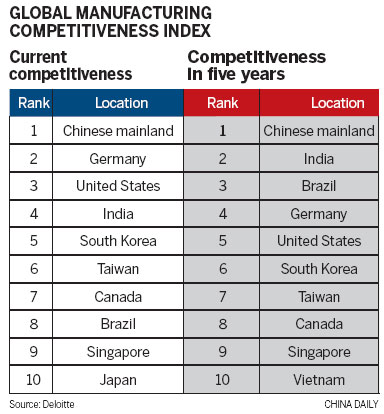

|
A worker checks products made for the Southeast Asian market at a textile factory in Huaibei city, Anhui province. Xie Zhengyi / for China Daily |

Two major developments that took place earlier this year are expected to have far-reaching implications for the global manufacturing sector, and particularly in China. At first glance, they appear to be rather innocuous economic predictions. But a closer look reveals that while the global manufacturing industry is tottering, China is still proving to be the lifeline for many global companies.
The 2013 Global Manufacturing Competitiveness Index prepared by global professional service firm Deloitte Touche Tohmatsu Ltd and the US Council on Competitiveness, released in January, indicates that China is not only the most competitive manufacturing nation in the world presently, but will continue to retain that ranking for the next five years.
However, that does not mean that everything is hunky-dory in China, as its relatively strong manufacturing edifice is facing severe challenges such as a sharp decline in the absolute working-age population.
Ma Jiantang, the National Bureau of Statistics chief, had earlier in January indicated that though China's labor force had declined by 3.45 million last year to 937 million, it still continued to be the nation's "biggest resource advantage".
|
||||
However, the decline in China's working-age population is something that most economists would not have anticipated as it comes three years ahead of the previous predictions made by the World Bank. The country's demographic dividend - when the largest section of society is of working age and the dependency ratio is low - has contributed to more than 30 percent of its rapid economic growth, an earlier World Bank report said.
In real terms, what the decline in working-age population means is that the endless supply of cheap labor from China, which accounts for more than 11 percent of the world's exports, is no longer a reality, but a memory.
